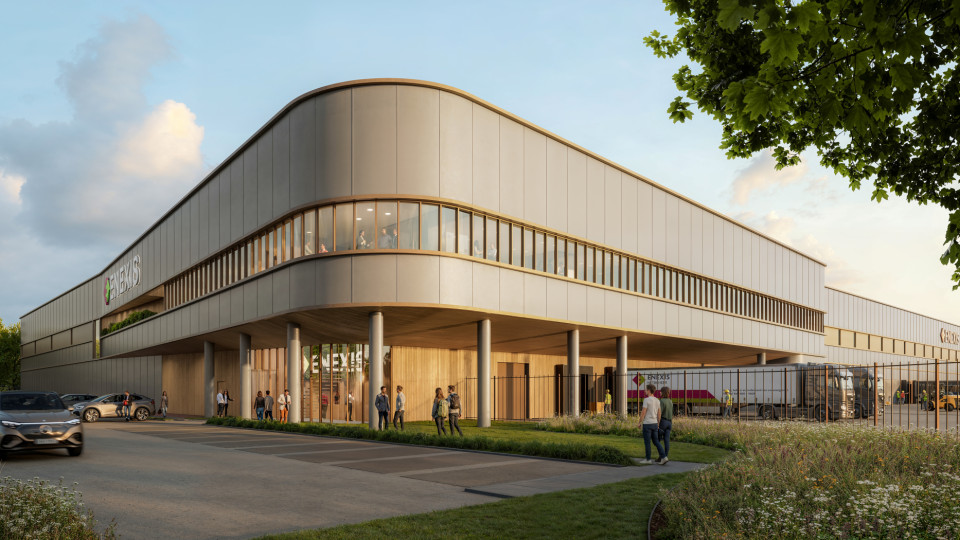In 2000, Paul de Ruiter Architects were commissioned to design a new regional office for the Rijkswaterstaat in Zeeland (this is the executive agency of the Ministry of Infrastructure and Water Management). The brief called for a functional, sustainable, accessible, adaptable and financially responsible building that corresponded with the urban development plan for the city of Middelburg. It also requested the building be geared to the needs and well-being of Rijkswaterstaat personnel and fulfil a specific communicative role, both internally and externally. Our design met all of the client’s requirements and pioneered innovations that extended the boundaries of sustainable architecture.
The link between the city and the countryside
Middelburg’s urban development plan was drawn up with the intention of raising the city’s national profile. One of the tasks set out by the plan was the restoration of the link between the city centre and Middelburg Zuid, the southern part of the city — which at the time was isolated by a canal — a restoration to be achieved by constructing a series of landmarks along the canal that would mark the new boundary between the city and the countryside and turn Middelburg Zuid and the centre into a single urban area once again. The Rijkswaterstaat’s new regional office was to be one of these landmarks.
We designed the Rijkswaterstaat building as an elongated geometric form that conveys the authority of the office, on account of its compactness, but that also exudes lightness, on account of its elevation on pillars and the abundant use of glass in the façade. Elevating the building allowed us to use its entire base as a car park and preserve as much of the surroundings as possible in its natural state.
More than just an office
The building serves not only as the regional office of the Rijkswaterstaat, but also as a crisis centre, a home for the state archives and a computer centre that, in the event of an emergency, will control all the sluice gates in the province of Zeeland, including the Delta works. This collection of functions meant the client needed a layout that lent itself to easy internal reorganisation, a requirement we met in two ways. First, by making the building adaptable in terms of its structure and in relation to its utility systems, the combination of which allows for internal reorganisations of all sorts and facilitates the renting out of large sections of the building. And second, by designing the office to correspond with the working practices of the organisation, whose 450 employees were mostly fieldworkers and thus spent much of their time away from the office. This we did by equipping the building for hot desking/activity-based work, which by its nature demands operational flexibility.
The building fulfils an important communicative role, both internally and externally. Externally, the office needed to portray an image in keeping with a public service building, with the emphasis on “public”. To this end, we made extensive use of glass in the north and south facades — especially on the first floor, which is wrapped entirely in glass — thereby making the activity within visible to passers-by and portraying the Rijkswaterstaat as open and accessible, as opposed to closed-off and forbidding, as is often the public’s perception of government offices, where decisions are assumed to be taken behind closed doors. The internal layout, for its part, promotes employee interaction and reinforces the organisational culture of accessibility and knowledge sharing. Hot desking provisions and glass partitions between corridors and offices provide lots of opportunity for contact, and spacious corridors with a variety of comfortable, informal and semi-formal meeting spots — including coffee corners — make sharing ideas both easy and more likely.
Project details
Gegevens
| Location | Poelendaelesesingel 18, 4335 JA Middelburg |
| Gross floor area | 11,835 m² |
| Project description | Office with crisis center, state archives and computer center |
| Start design | January 2000 |
| Start construction | May 2003 |
| Construction | November 2004 |
Ontwerpteam
| Client | The Central Government Real Estate Agency |
| Tenant | Rijkswaterstaat Zeeland |
| Project architect | Paul de Ruiter |
| Project team | Dieter Blok, Monique Verhoef, Willeke Smit, Helga Traksel, Michael Noordam, Sander van Veen, Emma Franks, Melanie Go, Florent Rougemont, Jeroen Quanjer, Nicolle Flagiello |
| Construction consultant | ABT |
| Building services engineering | Halmos |
| Sustainability consultant | moBius consult |
| Structural engineering | moBius consult |
| Geothermal energy consultant | If technology |
| Interior supervisor | Paul de Ruiter Architects |
| Interior design | Hidde ontwerp en organisatie |
| Landscape architect | Bosch & Slabbers |
| Urban design | BVR, Palmboom & van der Bout |
| Artists | Dan Peterman (Chicago, USA), Olafur Eliasson (IJsland) |
| Contractor | BAM Utiliteitsbouw |
| Electrical systems | Alewijnse Delft |
| Mechanical engineering | GTI Utiliteit Zuid |
| Photography | Pieter Kers and Rob 't Hart |










